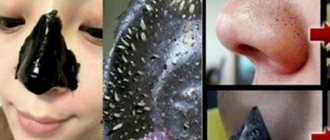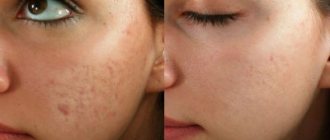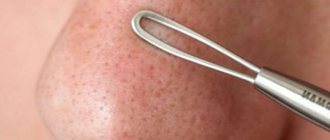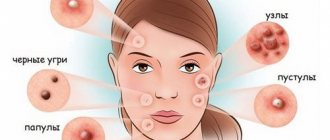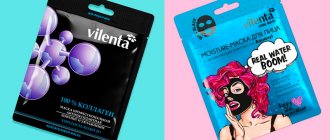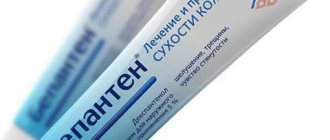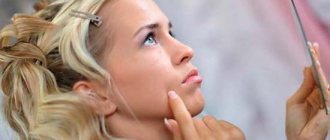What are subcutaneous acne on the forehead?
The forehead is a natural area where acne is likely to occur. The T-shaped part of the face (chin, nose, forehead) has the highest content of sebaceous glands. The area near the forehead is also susceptible to subcutaneous rashes because the skin there is much thicker.
The glands secrete a significant amount of fat; due to contamination or malfunction, it does not find a way out, and thus a rash appears on the forehead in the form of small white pimples.
In a situation where the problem is not addressed in a timely manner, optimal conditions arise for the proliferation of harmful bacteria. Inflammation occurs and in place of small white bumps, the entire area of the forehead is surrounded by red pimples.
Pimples on the forehead form in much the same way as on other parts of the body. The oil produced by the sebaceous glands is extremely important for the proper functioning of the skin. Fat helps create a protective film on the body that reliably protects it from external adverse factors - cold, heat, rain.
At the same time, subcutaneous fat, mixing with sweat and dust, clogs the mouth of the glands with plugs. The secretion produced by the glands cannot find its way out; it accumulates in the sebaceous ducts.
This is an excellent environment for the intensive proliferation of harmful bacteria. An inflammatory process occurs, suppuration forms and, as a result, a subcutaneous tumor near the forehead.
On this topic
- Pimples
13 ways to prevent acne
- Inna Viktorovna Zhikhoreva
- March 29, 2020
They appear gradually: initially a slight compaction forms under the skin. It is characterized by slight pain and rapid growth, then an inflammatory process is added. This type of acne develops over a long period of time, causing pain and discomfort. It happens that ripening can take weeks.
The sebaceous ducts will be completely engulfed in inflammation and it will not be possible to get rid of the manifestations soon. When a large amount of purulent content accumulates, quite large nodes form under the skin. In some cases, cystic neoplasms may appear.
Acne medications
If a large subcutaneous pimple has appeared on your forehead and is swollen around, you can use medications . At the same time, any self-medication options are unacceptable. To cope with the problem, you need to consult a dermatologist. Most often, doctors prescribe the following drugs:
- Azelaic acid - a product such as Skinoren, reduces the secretion of the sebaceous glands,
- Zinerit is an antibacterial ointment that perfectly dries the dermis and eliminates inflammation.
- Metrogyl gel - this product has an antimicrobial effect and copes with inflammation, allowing you to eliminate acne at the initial stage,
- Baziron AS - this gel has pronounced antimicrobial properties,
- Zinc ointment is considered one of the most effective remedies for treating acne,
- Salicylic acid – works great for pimples and acne on the forehead.
Causes
When acne on the forehead appears extremely often, the first thing you should do is change your skin care and balance your diet. If such measures are not crowned with positive results, therefore, the provoking factor must be sought through medical diagnosis.
The causes of subcutaneous tumors in the forehead area are:
- Hormonal disorder. For example, during pregnancy or the menstrual cycle in women, the content of fat produced increases. This will be the cause of acne formation. By normalizing the hormonal balance, everything will go away on its own. However, there are more serious factors - female diseases (hyperandrogenism). In the presence of such symptoms, acne develops. Its development indicates the need for additional diagnostics and therapy selected by a specialist.
- Inadequate facial skin care In the process of using cosmetics of poor quality, comedogenic drugs and if hygiene rules are not followed, the body gives alarm signals about malfunctions in the form of a rash in the forehead.
- Unbalanced diet . Food plays a key role in the condition of the skin. Abuse of harmful allergenic products, chemical additives, fried, salty and sweet foods in unlimited quantities provokes the formation of a rash on the skin of the face.
- Dysfunction of the gastrointestinal tract. The appearance of acne on the forehead often indicates unstable bowel function.
- Excessively cold or hot temperature. The skin has protective functions; a natural reaction to an increase or decrease in temperature indicators will be increased functioning of the sebaceous glands. In hot weather, they should protect the skin from burning, and in cold weather, from frostbite.
- Irritation. A subcutaneous rash on the forehead can occur due to an allergy to improperly selected fabrics and clothing materials. For example, when a headdress does not fit in size, touches the skin tightly, or is made of artificial material, this contributes to the formation of unpleasant acne. They can only go away after the allergen is eliminated.
- Medications . Often, the occurrence of a rash can be facilitated by the use of antibiotics and contraception.
On this topic
- Pimples
5 ways to get rid of acne right now
- Inna Viktorovna Zhikhoreva
- March 29, 2020
When the forehead is covered with pimples, but the patient is able to fully limit the impact of irritating factors, then it is necessary to understand what internal causes can cause the rash.
In a situation where the occurrence of a rash in the forehead is a common occurrence, and it is characterized by an inflammatory process, you should contact a specialist for examination.
Features of facial skin care
To prevent future breakouts, you need to take proper care of your facial skin.
Most drugs have a positive effect on the dermis only after regular use, but complex measures help to significantly reduce the inflammatory process after just a few doses.
The human body is a complex mechanism, therefore measures taken for the overall health of the facial skin (a balanced diet or adequate sleep) will only increase the effect of cosmetic products for the care of the facial dermis.
Symptoms
Due to the further formation of inflammation, infection of the damaged area with bacteria that are constantly present on the human skin, an internal purulent pustule appears.
On the outside, this phenomenon is a white or yellow growth that protrudes above the skin and has no way out. Since the pus is completely hidden by a layer of skin, it is extremely difficult to eliminate such a formation.
In certain situations, the accumulation of significant amounts of pus leads to the rapid development of a rash. During advanced pathology, large nodes will give the skin its characteristic bumpiness and bright red color.
On this topic
- Pimples
How to quickly get rid of acne on the chin
- Inna Viktorovna Zhikhoreva
- September 27, 2020
Pimples in the forehead area may not form purulent pustules for a long time, causing itching, discomfort, and pain when touched. Small internal pimples are often located, in addition to the forehead, on the nose and lips, causing general inflammation in these areas.
When the disease is caused by a subcutaneous mite, the rash is multiple, has an unnatural reddish tint and is localized under a thin layer of skin. In some situations, symptoms are supplemented by itching and flaking.
Types of acne
- The initial form is comedones. These are small, non-inflamed pimples, which are sebaceous plugs blocking the ducts of the skin glands. They come in 2 types: open and closed. In the first case, the top layer of their contents oxidizes, forming black dots that can be easily squeezed out if desired.
- When buried deeper, they look like light balls - these are whiteheads, or milia. When they are squeezed, the filling is released with difficulty.
Types of inflamed formations:
- Papules, or red pimples, are watery bumps that are painful on palpation.
- Pustules - most often formed from the red variety, are distinguished by the presence of a purulent core.
- Nodules are subcutaneous bumps. They are large, hard, painful, and can cause itching and severe hyperemia. After they heal, dark spots often remain.
- Cysts are soft internal pimples that can unite into one large abscess.
- Multiple (conglobate) rashes are the most severe form of pathology. Abscesses and subcutaneous seals merge into a single bluish-red inflammatory formation. In their place, rough scars remain.
Diagnostics
In order to establish the root cause of a rash on the forehead, it is necessary to seek help from a qualified dermatologist, in particular when the rash constantly forms and does not go away while using various ointments and gels. Self-treatment should be stopped, as these actions can only aggravate the situation and lead to a deterioration in the condition of the skin.
The doctor carefully examines the skin on the face, and when necessary, prescribes a scraping for pathogenic bacteria (staphylococcus, subcutaneous mites or other microorganisms). When the situation involves complex diagnostics, consultation with other specialized specialists is prescribed:
- Gastroenterologist. It checks the entire gastrointestinal tract for the presence of pathological processes, during which the skin itself removes substances unnecessary in the body. In such a situation, toxins clog the sebaceous ducts of the epidermis and provoke the occurrence of a rash.
- Gynecologist. A rash on the forehead in women is often associated with gynecological difficulties. By visiting a specialist, you can prevent the risk of ovarian diseases. Diagnosis is carried out using an ultrasound machine, which makes it possible to detect the pathological process at the initial stage.
- Endocrinologist. A problem with a rash on the forehead may indicate hormonal imbalances. The doctor recommends a blood test to verify the need for the chosen therapy and to prescribe effective medications.
Treatment
It is forbidden to squeeze pimples on the forehead, as this can cause infection, increase the number of rashes, and also provoke serious health consequences.
Treatment of inflammatory processes on the skin is often a lengthy process. This is assumed to be the active secretion of subcutaneous sebum in this area of the face. Treatment begins with eliminating the root cause that caused such a pathology.
Cosmetic treatment
If there is minor damage to the skin of the forehead, it is recommended to visit a cosmetologist in order to implement a set of measures to counteract subcutaneous acne. These include the following:
- Professional masks that prevent the appearance of rashes.
- Cleaning the skin.
- Microdermabrasion. A skin peel that uses hard crystals to remove dead skin cells. It has a beneficial effect on accelerating blood circulation and improves the general condition of the dermis.
- Acid peeling. Identical to the above method, however, the active component is able to penetrate deeper into the cells.
- Laser resurfacing. The top layer of cells is removed using a laser.
- Disincrustation. Opening the tumor and removing pus.
- Mesotherapy. The introduction of medications under the skin that help eliminate the inflammatory process and restore it.
These measures can be taken after prior consultation with a doctor.
Drug therapy
In difficult situations of skin damage in the forehead area, systemic and local treatment is prescribed:
- Antibacterial therapy.
- Use of systemic retinoids.
- Hormonal treatment.
- Use of vitamins A, E, C, B.
- Taking zinc supplements.
- Autohemotherapy.
- Use of topical retinoids
- Rubbing the affected areas with a 3% solution of salicylic acid, rubbing in ichthyol ointment.
The selection of drugs should be carried out by the attending physician.
Physiotherapy
Physiotherapy and hardware methods for treating internal acne in the forehead area involve:
- Ultraviolet irradiation (has a beneficial effect on eliminating rashes and counteracts pathogenic microorganisms).
- Phototherapy (used for speedy tissue restoration).
- Magnetic therapy (characterized by a resorption effect).
- Ozone therapy (eliminates swelling, inflammation and destroys harmful bacteria through oxygen).
- Elos therapy (influence on inflamed areas with blue light pulses).
Before prescribing such manipulations, a comprehensive diagnosis should be carried out.
Prevention
If you are predisposed to an internal rash on the forehead or have oily skin, it is recommended to follow the instructions to prevent the occurrence of subcutaneous acne:
- Diet excluding sweet and spicy foods. Saturation of the diet with fresh vegetables, fruits, dairy products, fish.
- Walking in the air, physical exercise.
- Limiting bad habits.
- Daily skin care It is prohibited to use decorative cosmetics that interfere with the outflow of sweat and subcutaneous sebum.
- Elimination injuries . If it is damaged, it is necessary to promptly disinfect it.
- Using herbal tinctures to wash and wipe the skin.
- Elimination of overheating and hypothermia.
- Therapy of chronic diseases, prevention of viral diseases.
On this topic
- Pimples
Everything you need to know about subcutaneous acne
- Inna Viktorovna Zhikhoreva
- September 27, 2020
By following the above recommendations, you can protect yourself from this phenomenon.
If the disease is neglected, then internal acne in the forehead area will be difficult and painful to treat. Therefore, at the first appearance of a rash, it is necessary to use antibacterial agents, preventing harmful microorganisms from developing, and the rash will not appear. You should not forget about taking preventive measures, thereby preventing the occurrence of acne on the forehead.
